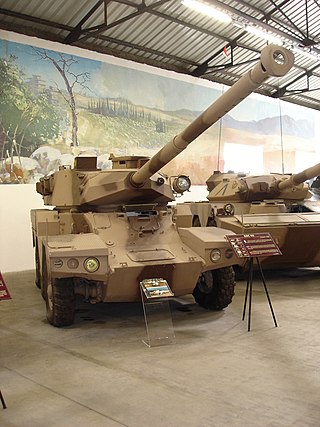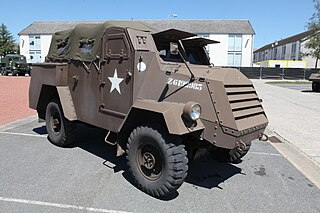
The Cromwell tank, officially Tank, Cruiser, Mk VIII, Cromwell (A27M), was one of the series of cruiser tanks fielded by Britain in the Second World War. Named after the English Civil War-era military leader Oliver Cromwell, the Cromwell was the first tank put into service by the British to combine high speed from a powerful, reliable engine and reasonable armour. The intended dual-purpose high velocity gun could not be fitted in the turret, so a medium velocity dual purpose gun was fitted instead. Further development of the Cromwell combined with a high velocity gun led to the Comet tank.

Leyland Motors Limited was an English vehicle manufacturer of lorries, buses and trolleybuses. The company diversified into car manufacturing with its acquisitions of Triumph and Rover in 1960 and 1967, respectively. It gave its name to the British Leyland Motor Corporation, formed when it merged with British Motor Holdings in 1968, to become British Leyland after being nationalised. British Leyland later changed its name to simply BL, then in 1986 to Rover Group.

Alvis Car and Engineering Company Ltd was a British manufacturing company in Coventry from 1919 to 1967. In addition to automobiles designed for the civilian market, the company also produced racing cars, aircraft engines, armoured cars and other armoured fighting vehicles.

The Rolls-Royce Armoured Car is a British armoured car developed in 1914 and used during the First World War, Irish Civil War, the inter-war period in Imperial Air Control in Transjordan, Palestine and Mesopotamia, and in the early stages of the Second World War in the Middle East and North Africa.

The Musée des Blindés or Musée Général Estienne is a tank museum located in the Loire Valley of France, in the town of Saumur. It is now one of the world's largest tank museums. It began in 1977 under the leadership of Colonel Michel Aubry, who convinced both the French military hierarchy and the local political authorities. Started 47 years ago with only a few hundred tracked vehicles, it has become a world-class collection which attracts visitors interested in the history of multinational tank development as well as professional armor specialists. From the very beginning, Colonel Aubry had made it a key policy of the museum to restore to running condition as many historically or technically significant vehicles as was feasible.
Bedford Vehicles, usually shortened to just Bedford, was a brand of vehicle manufactured by Vauxhall Motors, then a subsidiary of multinational corporation General Motors. Established in April 1931, Bedford Vehicles was set up to build commercial vehicles. The company was a leading international lorry brand, with substantial export sales of light, medium, and heavy lorries throughout the world.

Guy Motors was a Wolverhampton-based vehicle manufacturer that produced cars, lorries, buses and trolleybuses. The company was founded by Sydney S. Guy (1885–1971) who was born in Kings Heath, Birmingham. Guy Motors operated out of its Fallings Park factory from 1914 to 1982, playing an important role in the development of the British motor industry.

The Marmon-Herrington Armoured Car was a series of armoured vehicles that were produced in South Africa and adopted by the British Army during the Second World War. RAF Armoured Car companies possessed them, but seem never to have used them in action, making greater use of Rolls-Royce Armoured Cars and other types.

An artillery tractor, also referred to as a gun tractor, is a specialized heavy-duty form of tractor unit used to tow artillery pieces of varying weights and calibres. It may be wheeled, tracked, or half-tracked.

The C15TA Armoured Truck was an armoured load carrier produced by Canada during the Second World War. It was developed from the Otter Light Reconnaissance Car.

The Lanchester armoured car was a British armoured car built on the chassis of the Lanchester "Sporting Forty", it saw wide service with the Royal Naval Air Service and British Army during the First World War. The Lanchester was the second most numerous World War I armoured car in British service after the Rolls-Royce armoured car.

The Austin Armoured Car was a British armoured car produced during the First World War. The vehicle is best known for its employment by the Imperial Russian Army in the First World War and by different forces in the Russian Civil War.

During the First World War, sixteen American Peerless trucks were modified by the British to serve as armoured cars. These were relatively primitive designs with open backs, armed with a Pom-pom gun and a machine gun, and were delivered to the British Army in 1915. They were used also by the Imperial Russian Army as self-propelled anti-aircraft guns.

Canadian Military Pattern (CMP) trucks were mutually coherent ranges of military trucks, made in large numbers, in several classes and numerous versions, by Canada's branches of the U.S. 'Big Three' auto-makers during World War II, compliant to British Army specifications, primarily intended for use in the armies of the British Commonwealth allies, but also serving in other units of the British Empire.

Throughout its history, the Irish Army has used a number of armoured fighting vehicles.

The Bedford Dunstable plant was a truck and bus vehicle assembly plant, located in Dunstable, Bedfordshire, England. Developed and opened by Vauxhall Motors in 1942 under instruction from the Ministry of Production as a shadow factory, it was transferred to the Bedford Vehicles unit in the 1950s. Closed after receivership in 1992, it was subsequently demolished and redeveloped as a retail park and associated industrial estate.

The Leyland Beaver-Eel, known officially as the Tender, Armoured, Leyland Type C, was an armoured truck used by the Royal Air Force throughout World War II for airfield defence duties.

The Leyland Hippo Mk II was a heavy general service cargo truck used by the British Army and Royal Air Force during World War II and the immediate post-war years.

















